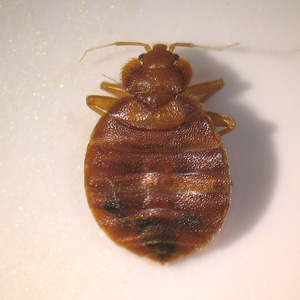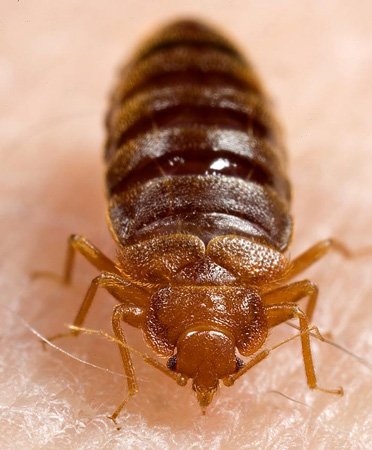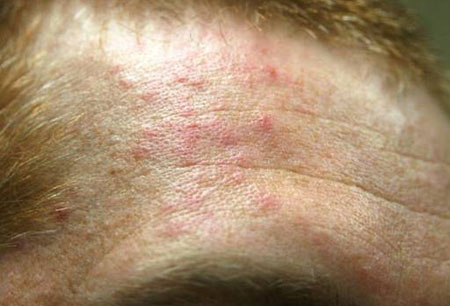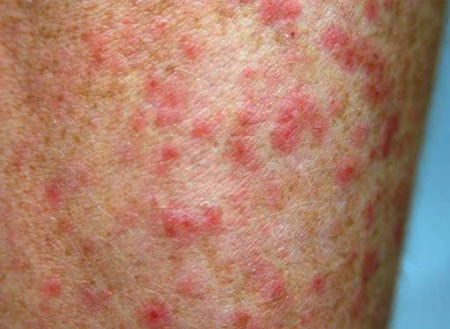History and physical examination
Social and travel history are essential in determining risk of exposure to infestation. Recognised risk factors include sleeping in a high-turnover environment (e.g., hotel, hall of residence, or homeless shelter), recent travel, and the presence of second-hand furniture and/or mattresses in the home.[4]Reinhardt K, Siva-Jothy MT. Biology of the bedbugs (Cimicidae). Ann Rev Entomol. 2007 Jan 7;52:351-74.
http://www.ncbi.nlm.nih.gov/pubmed/16968204?tool=bestpractice.com
[9]Potter M; University of Kentucky College of Agriculture, Food and Environment. Bed bugs. 2020 [internet publication].
https://entomology.ca.uky.edu/ef636
[10]Delaunay P. Human travel and traveling bedbugs. J Travel Med. 2012 Dec;19(6):373-9.
https://academic.oup.com/jtm/article/19/6/373/1795480
http://www.ncbi.nlm.nih.gov/pubmed/23379708?tool=bestpractice.com
[20]Aoki V, Millikan RC, Diaz LA, et al. Environmental risk factors in pemphigus foliaceus (fogo selvagem). J Investig Dermatol Symp Proc. 2004 Jan;9(1):34-40.
https://www.jidsponline.org/article/S0022-202X(15)52979-5/fulltext
http://www.ncbi.nlm.nih.gov/pubmed/14870983?tool=bestpractice.com
Any sighting of bed bugs in the patient's environment (e.g., crevices of mattresses, bed bases, and bed headboards and behind skirting boards) should be noted. Occasionally, patients may report specks of blood or faeces on their bed sheets or mattress. Patients may also report a sweet, musty odour, which is emitted by bed bugs and is characteristic of infestation.[2]Parola P, Izri A. Bedbugs. N Engl J Med. 2020 Jun 4;382(23):2230-7.
http://www.ncbi.nlm.nih.gov/pubmed/32492304?tool=bestpractice.com
Ink dot-like spots on headboards and mattresses or blood stains on sheets are also clues to bed bug infestations in the bedroom.[25]British Pest Control Association. Pest advice for controlling bed bugs [internet publication].
https://bpca.org.uk/pest-aware/Page-2/bed-bugs-control-how-to-get-rid-of-bed-bugs-bpca-a-z-of-pests/189186
However, when asked, they will often deny knowledge of any recent insect bite. Patients often report new lesions in the morning and may describe an intense pruritus. Although lesions are not usually painful, patients may report pain or a burning sensation.
Patients most commonly present with erythematous papules, 1 to 5 mm in size, arranged in a curved or linear pattern on skin exposed during sleep (e.g., face, neck, arms, legs, and shoulders).[7]McNeill C, Jarrett A, Shreve DM, et al. Bed bugs: current treatment guidelines. J Nurse Pract. 2017 Jun;13(6): P381-8.
https://www.npjournal.org/article/S1555-4155(17)30274-X/fulltext#secsectitle0040
A small central haemorrhagic punctum may be seen.[3]Goddard J, deShazo R. Bedbugs (Cimex lectularius) and clinical consequences of their bites. JAMA. 2009 Apr 1;301(13):1358-66.
http://jama.jamanetwork.com/article.aspx?articleid=183643
http://www.ncbi.nlm.nih.gov/pubmed/19336711?tool=bestpractice.com
[12]Kolb A, Needham GR, Neyman KM, et al. Bedbugs. Dermatol Ther. Jul-Aug 2009;22(4):347-52.
http://www.ncbi.nlm.nih.gov/pubmed/19580578?tool=bestpractice.com
Lesions may occur hours to days after being bitten.[7]McNeill C, Jarrett A, Shreve DM, et al. Bed bugs: current treatment guidelines. J Nurse Pract. 2017 Jun;13(6): P381-8.
https://www.npjournal.org/article/S1555-4155(17)30274-X/fulltext#secsectitle0040
The interval between bite and reaction may decrease as the host is repeatedly exposed.[8]Heymann WR. Bedbugs: a new morning for the nighttime pests. J Am Acad Dermatol. 2009 Mar;60(3):482-3.
http://www.ncbi.nlm.nih.gov/pubmed/19231644?tool=bestpractice.com
Other less commonly reported clinical presentations include papular or diffuse urticaria, bullous lesions, and, rarely, anaphylaxis.[3]Goddard J, deShazo R. Bedbugs (Cimex lectularius) and clinical consequences of their bites. JAMA. 2009 Apr 1;301(13):1358-66.
http://jama.jamanetwork.com/article.aspx?articleid=183643
http://www.ncbi.nlm.nih.gov/pubmed/19336711?tool=bestpractice.com
[7]McNeill C, Jarrett A, Shreve DM, et al. Bed bugs: current treatment guidelines. J Nurse Pract. 2017 Jun;13(6): P381-8.
https://www.npjournal.org/article/S1555-4155(17)30274-X/fulltext#secsectitle0040
[Figure caption and citation for the preceding image starts]: Cimex lectularius, collected in a hotel in urban GeorgiaCourtesy of the CDC [Citation ends]. [Figure caption and citation for the preceding image starts]: Cimex lectulariusCourtesy of the CDC [Citation ends].
[Figure caption and citation for the preceding image starts]: Cimex lectulariusCourtesy of the CDC [Citation ends]. [Figure caption and citation for the preceding image starts]: Bed bug bites showing numerous erythematous papulesFrom the contributors' personal teaching collection (Julian J. Trevino, David R. Carr, Suzanne L. Dundon); used with permission [Citation ends].
[Figure caption and citation for the preceding image starts]: Bed bug bites showing numerous erythematous papulesFrom the contributors' personal teaching collection (Julian J. Trevino, David R. Carr, Suzanne L. Dundon); used with permission [Citation ends]. [Figure caption and citation for the preceding image starts]: Linear distribution of papulesFrom the contributors' personal teaching collection (Julian J. Trevino, David R. Carr, Suzanne L. Dundon); used with permission [Citation ends].
[Figure caption and citation for the preceding image starts]: Linear distribution of papulesFrom the contributors' personal teaching collection (Julian J. Trevino, David R. Carr, Suzanne L. Dundon); used with permission [Citation ends].
Laboratory investigations
Diagnosis is based on clinical grounds, and further investigation is rarely necessary. A skin scraping of lesion (with mineral oil preparation) may be useful to exclude scabies as an alternative diagnosis. No bed bug-specific allergen-based tests are available for prick or intradermal skin testing to confirm bed bugs as an aetiological cause of urticaria.[3]Goddard J, deShazo R. Bedbugs (Cimex lectularius) and clinical consequences of their bites. JAMA. 2009 Apr 1;301(13):1358-66.
http://jama.jamanetwork.com/article.aspx?articleid=183643
http://www.ncbi.nlm.nih.gov/pubmed/19336711?tool=bestpractice.com
Rarely, a skin biopsy may be performed, although histopathological findings are usually non-specific and consistent with an arthropod bite reaction. Bullous reactions to bed bug bites, however, reflect a local cutaneous vasculitis with histology resembling that of Churg-Strauss syndrome.[26]DeShazo RD, Feldlaufer MF, Mihm MC Jr, et al. Bullous reactions to bedbug bites reflect cutaneous vasculitis. Am J Med. 2012 Jul;125(7):688-94.
https://www.amjmed.com/article/S0002-9343(11)01029-1/fulltext
http://www.ncbi.nlm.nih.gov/pubmed/22560811?tool=bestpractice.com
When bed bug infestations are large, anaemia may also be seen on laboratory evaluation, but laboratory investigation is not part of the routine work-up for bed bugs.[11]Doggett SL, Dwyer DE, Peñas PF, et al. Bed bugs: clinical relevance and control options. Clin Microbiol Rev. 2012 Jan;25(1):164-92.
https://www.ncbi.nlm.nih.gov/pmc/articles/PMC3255965
http://www.ncbi.nlm.nih.gov/pubmed/22232375?tool=bestpractice.com
[27]Izri A, Marteau A, Ferreira T, et al. Severe anemia due to bed bugs hyperinfestation. Microb Pathog. 2020 Dec;149:104564.
http://www.ncbi.nlm.nih.gov/pubmed/33045337?tool=bestpractice.com
[28]Sheele JM, Pritt BS, Libertin CR, et al. Bed bugs are associated with anemia. Am J Emerg Med. 2021 Aug;46:482-8.
http://www.ncbi.nlm.nih.gov/pubmed/33221110?tool=bestpractice.com
 [Figure caption and citation for the preceding image starts]: Cimex lectulariusCourtesy of the CDC [Citation ends].
[Figure caption and citation for the preceding image starts]: Cimex lectulariusCourtesy of the CDC [Citation ends]. [Figure caption and citation for the preceding image starts]: Bed bug bites showing numerous erythematous papulesFrom the contributors' personal teaching collection (Julian J. Trevino, David R. Carr, Suzanne L. Dundon); used with permission [Citation ends].
[Figure caption and citation for the preceding image starts]: Bed bug bites showing numerous erythematous papulesFrom the contributors' personal teaching collection (Julian J. Trevino, David R. Carr, Suzanne L. Dundon); used with permission [Citation ends]. [Figure caption and citation for the preceding image starts]: Linear distribution of papulesFrom the contributors' personal teaching collection (Julian J. Trevino, David R. Carr, Suzanne L. Dundon); used with permission [Citation ends].
[Figure caption and citation for the preceding image starts]: Linear distribution of papulesFrom the contributors' personal teaching collection (Julian J. Trevino, David R. Carr, Suzanne L. Dundon); used with permission [Citation ends].